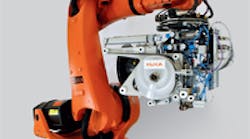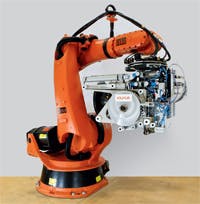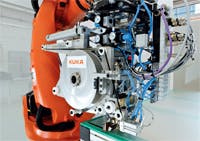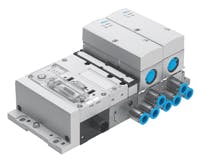By integrating robots into the production process, Kuka Systems GmbH, Augsburg, Germany, is developing high-speed, custom machines that trim, tape, and frame crystalline photovoltaic modules. Proportional electropneumatic technology ensures proper pressure is applied to the tape roll, and lets the system adjust taping processes on the fly. The result is fully automated, ready-to-use photovoltaic production lines for up to one million solar modules per year.
The system consists of three major segments. The Kuka Robo Trim robot cell removes laminate sheet coating and prepares the module for framing. This robot station for removing edge coatings entirely eliminates the manual activities required in conventional systems. The robot uses a special pneumatic gripper to pass a laminated photovoltaic module through the trimming station and prepare it for taping and framing.
Next, the Kuka Robo Tape robot station applies tape and sealant to the glass, accurately cuts the tape, and removes excess material. Pneumatic drives (types ADN, DFM, DSNU and DZF) from Festo, Esslingen, Germany load, guide, and control the tape rolls.
A groundbreaking feature, according to Kuka officials, is the advanced tape head attached to the robot. It travels along and applies tape to the passing solar module with cycle times of only 10 seconds, which helps optimize robot productivity.
Smart valves
Roll application pressure on the tape robot is controlled using a VPPM proportional valve connected to Festo’s CPX/MPA valve terminal. This proportional valve ensures process precision and makes it possible to set individual acceleration and pressure ramps. The proportional valves’ variable flow rates, in turn, adjust cylinder pressure to meet production process demands.
The CPX permits fieldbus and Ethernet connections, for on-site commissioning, pressure display, and diagnostic functions using HMIs in the field, or via the production-control system. Users can remotely control and monitor pressure and diagnostic data via the fieldbus.
In fact, the combination of proportional technology and the CPX’s capabilities even lets users perform remote maintenance and diagnostics via a web monitor, e-mail, or SMS alarm, further enhancing machine availability.
Robo frame
The Kuka Robo Frame is the next station in the fully automated production line. Here, the robot uses pneumatic drives, valves, and vacuum grippers to handle the prepared laminate on the glass side and accurately insert it into the frame.
In four steps, the robot first joins the long frame parts and then short frame parts and corner connectors. Precise gripping and a level support ensure that only minimal forces are exerted on the laminate during frame assembly, so the laminate does not deform. This also ensures there is no relative movement between panel and frame, thus preventing the profiles from getting scratched.
“This was the first time a frame press had been integrated directly into the robot,” explains Elisabeth Schrtl from Kuka’s engineering department. “We avoid deformations and scratches and so increase the quality compared with a standard frame press.”
Joining forces are comparable to those of a conventional 1.2-ton frame press. And the process can use double-sided adhesive tape or other sealing methods. Tooling can be adapted to various frame sizes, making the system scalable for different products using the same robots.
“Thanks to our process expertise acquired over many years in the automotive industry, we can supply photovoltaic module lines with nearly 100% process automation,” says Albert Vontz, product group director at Kuka. Robots are used in almost every production process, he says, from handling glass and linking cells, to bonding glass panels together with sealant to protect against air and humidity, as well as applying tape, framing, and packing.
For more information on Festo’s electropneumatic components, visit www.festo.com. For more information on Kuka robotic systems, visit www.kuka-systems.com.
Fieldbus-controlled proportional pressure regulator offers user benefits
Mounting a fieldbus-controlled proportional valve directly on a valve manifold is an approach machine builders should closely consider, according to officials from Festo Corp. It reportedly offers control flexibility as well as numerous cost-saving advantages, including fewer parts, simplified installation and maintenance, less wiring, and powerful remote diagnostics. The company’s VPPM-MPA proportional pressure regulator, for example, provides a precise means of varying supplied air pressure, via the valve manifold, to pneumatic actuators. This, in turn, facilitates accurate control of speed, force, pressure, and torque.
Proportional pressure regulators are used extensively in process and industrial automation. Typical applications include controlling the contact force in polishing and friction welding, controlling web tension, providing active load cushioning and weight compensation, controlling the speed of pneumatic motors, and regulating torque in pneumatic wrenches.
Designed specifically for use with MPA series valve manifolds, the VPPM-MPA proportional pressure regulator features a 0.12-in. proportional pressure valve and is available with pressure ranges of 0 to 2, 0 to 6, or 0 to 10 bar. The 0 to 10 bar model accommodates flow rates to 1400 l/min. With a cascaded, dual-stage regulator design – each with its own pressure sensor – the VPPM-MPA maintains extremely tight regulation under a wide range of operating conditions.
Festo’s MPA valve manifolds have a built-in serial bus which accommodates the fieldbus/Ethernet connections required by various modules that make up the system. These can include digital and analog I/O modules, pressure sensors and regulators, as well as the valves themselves. This simplifies integration of pneumatic and electrical operations – and significantly reduces installation time and cost.
VPPM-MPA proportional pressure regulators can be commissioned remotely via fieldbus or Ethernet, or locally by using Festo’s CPX-MMI handheld control unit. Programmable functions include setpoint, upper and lower limits, and a choice of three preset response profiles to fine tune the system without the need to set up complex PID loops. Both the programmed setpoint and actual pressure can be monitored locally or remotely, and users can display pressure in bar, MPa, or psi. The regulators can report a comprehensive range of diagnostic data via fieldbus or Ethernet, and are also equipped with front-panel LEDs to indicate power and operational status.
VPPM-MPA proportional pressure regulators can be mixed with standard and proportional valves on the same manifold. They can also be used for multiplexing, whereby a single VPPM-MPA module can sequentially switch to several different pressure settings - even across multiple MPA valve manifolds - to facilitate cost-effective pneumatic actuator control schemes.
Information for this story courtesy of Nicola Meadway, Festo Ltd., Fleet, Hampshire, United Kingdom.





